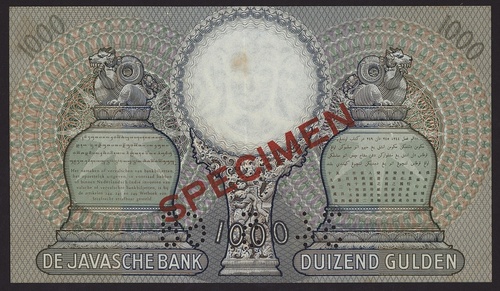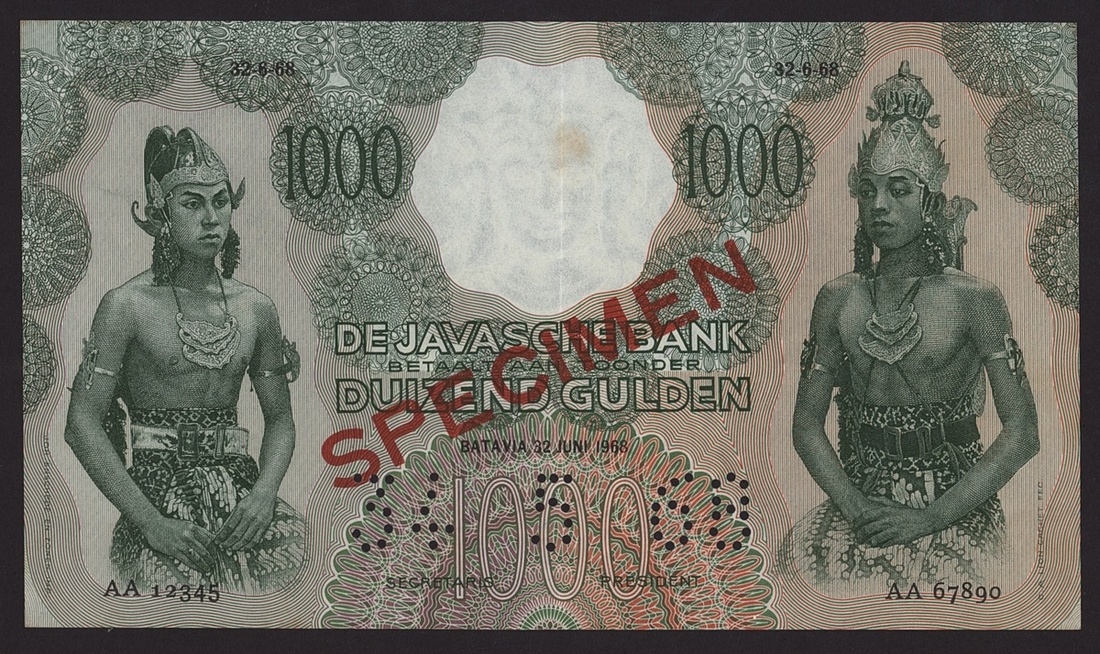Auction: 25008 - World Banknotes
Lot: 457
(x) De Javasche Bank. Netherlands Indies, Specimen 1000 Gulden, 1968, serial number range AA12345 - AA67890,
This 1000 Gulden specimen note dated “32 JUNI 1968” is a remarkable and historically resonant piece from the legacy of the Netherlands Indies, issued under the name of De Javasche Bank. Although never intended for circulation, this note, faithfully reproduces the design of the original Pick 85 note that was genuinely issued in 1938–1939. It features the same elaborate engraving and multilingual inscriptions, presenting a vivid portrayal of colonial-era banknote art. What makes this specimen particularly fascinating is the date itself: “32 June” is an impossible calendar date, deliberately printed to ensure the note could not be mistaken for a genuine circulating issue. This is further reinforced by the presence of a bold red “SPECIMEN” overprint and a perforated cancellation reading “34.5.68,” both of which unequivocally signal its non-circulating status and its role as an archival or demonstrative item, produced long after the dissolution of its issuing authority.
De Javasche Bank, established in 1828 in Batavia—modern-day Jakarta—was founded under royal charter by King William I of the Netherlands. It functioned as both a central bank and a commercial bank, enjoying a monopoly over the issuance of paper money in the Dutch East Indies. For well over a century, the bank underpinned the financial system of the colony, facilitating trade in commodities like sugar, coffee, rubber, and spices, and serving primarily Dutch and European business interests. While it was the central institution of monetary authority in the colony, it was also a reflection of its time—its services, policies, and priorities closely aligned with the rigid structures of colonial hierarchy. The population of the Dutch East Indies was a mosaic of native Indonesians, Chinese migrants, and European settlers, but access to financial instruments remained highly stratified. A note of 1000 Gulden was never meant for the average citizen; it was used almost exclusively in large-scale commercial transactions and interbank transfers, its value far exceeding the monthly earnings of most of the population.
The 1000 Gulden note was the highest denomination ever issued by De Javasche Bank and, with its sweeping artistic detail and inscriptions in Dutch, Malay, Javanese, and Chinese, it stood as a symbolic bridge across the colony’s diverse communities. Yet the world in which this note once circulated would soon vanish. Following the upheaval of World War II, the Japanese occupation, and the hard-fought Indonesian War of Independence, sovereignty was transferred from the Netherlands to the newly formed Republic of Indonesia in 1949. Just a few years later, in 1953, De Javasche Bank was nationalised and succeeded by Bank Indonesia. Although the institution ceased to exist, the legacy of its banknotes lived on, and in 1968, this specimen was produced—using the original design plates, but bearing a deliberately fictitious printed date and perforation. It was not created for deception or nostalgia, but as a technical or archival reference, preserving the artistry and structure of a financial instrument from a bygone era.
Today, this 1000 Gulden specimen stands as a rare survivor and a poignant historical document. It represents not only the highest denomination ever issued by De Javasche Bank, but also a final echo of Dutch colonial influence in Southeast Asia. In a single piece of paper—never circulated, yet officially printed—one can find the imprint of imperial finance, the complexities of colonial governance, and the enduring legacy of monetary design. Far more than a specimen, this note is a testament to a world that no longer exists, preserved with extraordinary clarity for future generations.
(Pick 85s) good extremely fine
Subject to 5% tax on Hammer Price in addition to 20% VAT on Buyer’s Premium.
Estimate
£4,500 to £6,500
Starting price
£4500







